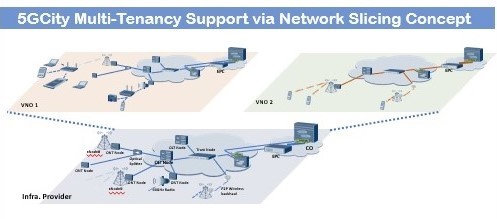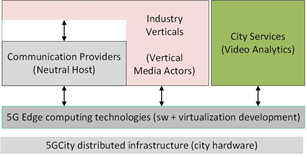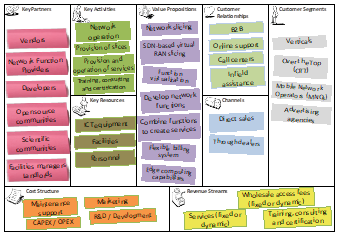
The Neutral Host model: some considerations from the TELCO point of view
The Model
The proposed model in 5GCITY consists in managing a network infrastructure to host (without imposing technical and economic constraints) any entity that uses it to provide its services to its end users.
In the model, the Neutral Host (the infrastructure owner) is the Operator who develops and manages the network and offers network capacity slices to the various 5G service providers, which can be TLC retail, OTT, Industries, the same Public Administration.
Challenges
In the development of 5G networks, especially in “enhanced Mobile Broadband” or “Ultra Low Latency” cases it is important to densify the access network to deal with the applications like the new ones in IoT context, Media and Energy vertical context.
The Neutral Host model is of the fundamental importance where the need is to densify the access network in order to reduce costs and maximize the use of available resources: in fact, a single operator provides access to network resources in a neutral, discriminating, maximizing efficiency in the use of scarce resources (e.g. radio frequencies, physical spaces such as cabinets, etc.).
The vertical operators (such as TLC operators) plays an important role in this model, providing end-to-end service to the final user in cases where radio coverage and mobility are crucial to ensuring the service with the expected requirements.
This model combines the vision of a physical network as a container of a set of virtual networks; the spectrum resources is an important element to combine in this frame: each of these networks is, in turn, made up of virtual resources realized using a portion of the allocated physical and spectrum resources and functionality that the specific “virtualization” or “slice” requires (according to the quality policies, security and encryption functions, functions routing, radio resource management capabilities, etc).

Figure 1: The 5G CITY Multi-Tenancy schema
Thanks to the synergistic work among the Neutral Host, TLC vertical operator, local public administrations, local businesses, it is possible to realize a telecommunications network by maximizing the reuse of existing infrastructures, while providing innovative and useful services to end users, particularly those expected by the citizens in smart communities.
The TELCO could be play also the role of Neutral Host providing for the availability of some specific applications and services to third-parties using the 5G network, allowing to build segmented slicing networks or mapping an application to a network slice or to use the solution offered by a different actor playing the role as Neutral Host able to define the slicing subnet for a given set of applications and to activate the necessary network functions by assigning the necessary configurations and parameterizations.
According to this, a TELCO can also participate to the Neutral Host model offering the capabilities to segment the various types of resources that can be used by third parties according to the capability that the mobile network can be partitioned into a variety of resources “slicing” destined for different services and purposes.
In particular, for a TELCO it is important for the model development to verify the coexistence of 5G technology and to interplay with the existing 4G network and the improvements that can be made to other WiFi-based solutions.
The scenarios of interest for a TELCO
5G City is dealing with different financial relevant market sectors of the new technology era, namely the Virtualized Enhanced Packet Core (VEPC), the (Multi-access Mobile) Edge Computing and the Small Cells ones. Those enable flexible network slicing with the needed virtualized computing resources and a dens coverage to address the requirements of all the mentioned verticals. Wind Tre is exploring in 5G City how to evolve the business opportunities according to the current and expected requirements coming from its future customers, either business or consumer.
- In the first scenario (Neutral Host), 5GCity leverages its virtualization platform to enable the cities (or any infrastructure provider) to create dynamic end-to-end slices containing both virtualized edge and network resources and lease it to third-party operators or verticals. The scenario consists of managing the underlying physical infrastructure to offer a set of virtual resources to an operator, who builds, on top, its own services ready for end-user consumption.
- The second scenario (Industry vertical) is strictly related to different aspects of the media and entertainment industry, which are strictly integrated into 5GCity project, and encompass all the Use Cases pivoting around video acquisition, editing and delivery.
- The third scenario is related to Smart City which is tailored to the specific needs of a city (e.g. Wind Tre in Lucca).

Figure 2: The 5GCITY Use cases
A possible business model could be based on a Neutral Host, as a Municipality, or an alternative option is that of joint/shared deployments of future networks, in a “RAN-sharing” mode. As part of the agreement, other involved MNOs take care of the deployment in other areas.

Figure 3: The 5G CITY Neutral Host Business Model
In general, it has been identified that Neutral Host should be the best model overall: Neutral Host offers network slices (that employ frequency resources) and the facilities to manage them. In principle, Neutral Host can have its own spectrum to share, or re-sell MNO’s owned spectrum, but these are not always viable scenarios in some countries. It is important to explore how to use the TELCO frequency-chain to realize a full/end-to-end network slice and services for the final client like as a content provider for live-streaming or Vod services.
In synthesis:
- 5GCity Neutral Host develops and provides “network slices” consisting of a set of virtualized resources that share the same physical infrastructure to different tenants.
- 5Gcity Neutral Host goes one step further providing an SDK tool that allows developers to create network functions and services and service providers to combine pre-existing functions in order to deploy new services.
- 5GCity RAN architecture innovates with multi-RAT function disaggregation, enabling SDN-based virtual RAN slicing and RAN function virtualization for LTE and Wi-Fi.
- 5GCity Neutral Host provides edge computing capabilities enabling ultra-low latency, high bandwidth and real-time access to radio network information that can be leveraged by applications.
- Both infrastructure and services dashboards provide advanced functionalities (e.g. billing) offering increased flexibility to mobile operators and other interested parties motivating them to adopt the Neutral Host model.
Furthermore, the TELCO can explore novel business models (both B-to-B and B-to-C) with a new flexibility in resource allocation and scaling, billing but also in clients’ requirements and type.
